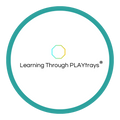Toy Labeling Ideas for Toddlers: Easy Setup for Teachers & Parents

Tidy-Up Time Tips: Labeling Toys for Toddlers and Preschoolers
Table of contents
If you’ve ever found yourself picking up the same toy bin for the hundredth time and wondering, “Why can’t they just clean it up themselves?” — this is for you.
Labeling your toy bins and shelves is one of the most powerful (and underrated!) tools in early childhood education. It builds independence, supports early literacy, and makes tidy-up time a whole lot easier.


Why Label Toys for Toddlers?
Supports Independent Clean-Up
Young children thrive when routines are clear and consistent. Labels help them know where things go — even if they can't read yet. Visuals act like little maps for their brains.
Boosts Early Literacy
Adding word labels alongside photos introduces print in a natural way. Children begin to recognize letters, connect meaning to words, and see language in action — a key step in emergent reading.
Encourages Thinking & Problem Solving
Sorting, matching, and returning items builds skills like organization, memory, and attention. It’s not just cleaning — it’s cognitive development at work.
Builds Confidence
When children can clean up on their own, they feel capable. It’s a simple way to say: “I believe in you.”
Brings Calm to the Classroom (or Home!)
A clearly labeled shelf = fewer meltdowns and less mess. That’s a win-win.
5 EASY Toy Label Ideas You Can Start Today






Here are five practical, research-backed ideas and tested by Kamilla (ECE & Founder) that make labeling approachable and effective:
1. 📸 Photo Labels
Take a real photo of the toy (e.g. LEGO blocks, cars, animals), print it, and tape it to the bin or shelf. Real-life images are especially effective for toddlers and visual learners.
2. 🔤 Word Labels
Add the name of the toy underneath the photo or as a stand-alone label. Keep the font clear and bold. This reinforces letter recognition and vocabulary in a print-rich environment.
3. 🧸 3D Object Labels
Glue or attach a real toy piece to the bin (e.g. a small car glued on the car box). These tactile labels help the youngest children recognize what's inside — perfect for toddlers still developing language.
4. ✂️ Shape-Matching Labels
Trace the shape of the toy (like a block or puzzle piece), cut it out, and tape the shapes to the shelf. Children can match by size and form — it turns clean-up into a shape-sorting game!
5. 🎨 Child-Made Labels
Empower your kids by letting them draw their own labels. This builds ownership, creativity, and makes them more likely to remember where toys go.
What the Research Says: HighScope’s Approach to Toy Labeling
The HighScope Curriculum , a research-based approach to early childhood education, emphasizes the importance of labeling and organizing the classroom environment. According to HighScope:
"Well-labeled materials stored in consistent locations support children’s independence, reduce conflicts, and help children plan and review their play."
Studies have shown that children in organized, clearly labeled environments exhibit higher levels of engagement, autonomy, and problem-solving skills . Labels create predictability — and young children thrive on that.
Labeling Toys the Montessori Way
In Montessori education , the environment is carefully prepared to promote independence, order, and self-direction — and labeling toys plays a key role in that setup. When toys are organized and clearly labeled, toddlers can choose activities independently and return them to their proper place, just like in a Montessori classroom. Using real photo labels, simple words, or matching shapes helps young children build responsibility and confidence while keeping their space tidy. This practice supports one of the core Montessori principles: “Help me do it myself.”
Visit the BLOG link below to learn more about Montessori and HighScope

But Remember… It Takes Time!
Don’t expect overnight results. Toddlers and preschoolers need lots of repetition, modeling, and encouragement to build a new habit.
Here’s how you can support:
🧍♀️ Model the behavior : Narrate what you’re doing: “I’m putting the animals in the bin with the picture of the cow.”
🎵 Make it fun : Add a cleanup song or a timer challenge to build enthusiasm.
🧠 Make it part of circle time : Introduce new labels during a group activity. Let children help match toys to the label or guess where each item goes.
🎉 Celebrate progress : Acknowledge effort, not perfection. “You found the puzzle bin all by yourself!”



